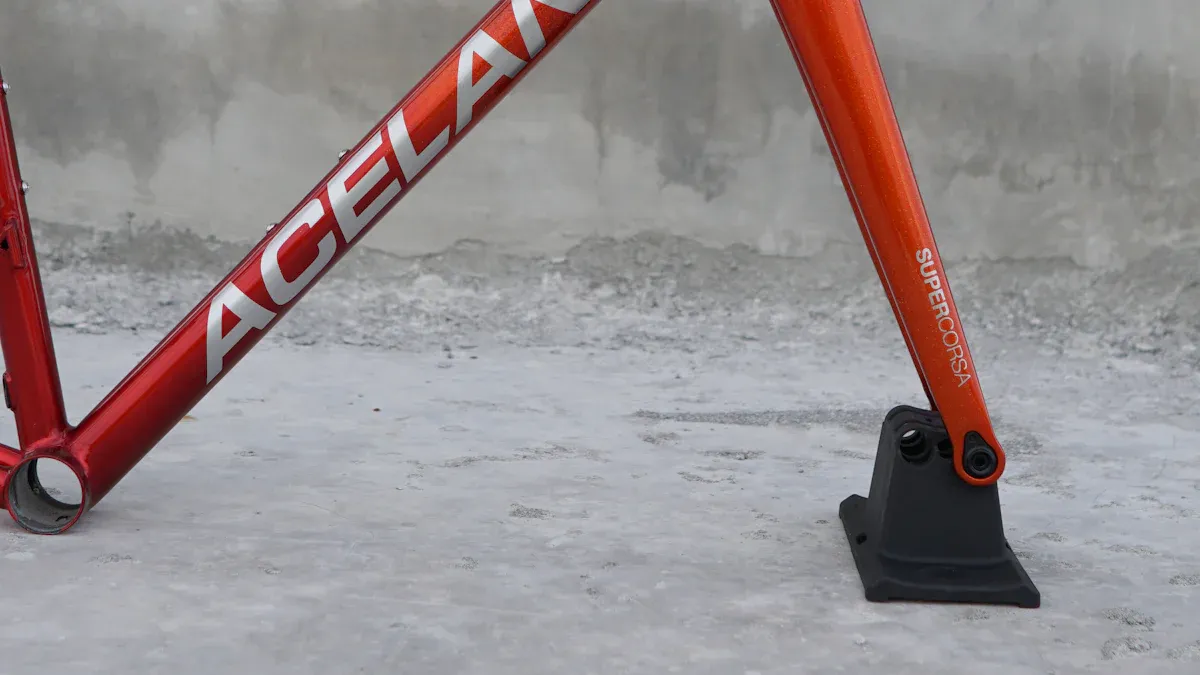
When you think about bike frames, the strongest bike frame material is crucial for ensuring strength. A strong frame provides better performance, lasts longer, and keeps you safe. Choosing the right materials can significantly enhance your riding experience. Here’s a quick look at the most common bike frame materials:
Material | Market Share |
|---|---|
Aluminum | Most Common |
Steel | Not as Popular |
Carbon Fiber | High Quality |
Titanium | Rare and Expensive |
Whether you want lightweight options or the strongest bike frame material, understanding these materials will help you make the best choice for your needs.
Key Takeaways
Aluminum frames are light and cheap. This makes them a favorite for casual riders. – Titanium is very strong and lasts a long time. It is great for long-term use, but it costs more. – Steel frames are tough and easy to fix. They are great for touring, but they weigh more than other materials. – Carbon fiber works really well. It has a high strength-to-weight ratio. However, it can be pricey and may not hold up well in hard hits. – Picking the right bike frame material depends on how you ride, your budget, and what feels comfortable.
Aluminium: A Lightweight Option

Aluminum frames are very popular with cyclists. This is for a good reason. This material has a great strength-to-weight ratio. It is a good choice for those who want to balance performance and weight. When you ride an aluminum bike, it feels light. This can help you go faster and be more agile on the road or trail.
Durability
Aluminum is light, but it is also fairly durable. The most common aluminum alloys used in bike frames are 6061-T6 and 7005. These have strong tensile strengths. For example, Aluminum 6061-T6 has a tensile strength of 241 to 320 MPa. Aluminum 7005 can reach up to 42 ksi. This means aluminum frames can handle a lot of stress without bending or breaking. But remember, aluminum has a set fatigue life. Over time, repeated stress can weaken it, which may cause failure.
Here’s a quick comparison of aluminum with other materials about fatigue life:
Material | Fatigue Life Characteristics |
|---|---|
Aluminum | Defined and finite, gradually weakening over time with repeated stress cycles. |
Carbon Fiber | Superior fatigue resistance, with an almost infinite fatigue life under ideal conditions. |
Steel | Good fatigue life but can develop fatigue over time. |
Advantages and Disadvantages
Aluminum bike frames have several advantages and disadvantages. Here’s a quick overview:
Advantages | Disadvantages |
|---|---|
Lightweight | Ride Quality |
Stiffness | Fatigue Life |
Durability | Limited Repairability |
Affordability | Less Design Flexibility |
Versatility |
You’ll see that aluminum frames are often cheaper than titanium or carbon fiber ones. They also have good versatility. This makes them good for many cycling styles, from casual rides to competitive racing. However, some cyclists think aluminum frames can affect ride quality compared to steel or carbon fiber options.
Titanium: The Strongest Bike Frame Material
When you think about bike frames, titanium is one of the strongest materials. This metal has special qualities that make it great for high-performance bikes. You may wonder why titanium is so unique. Let’s look at its durability and other features.
Durability
Titanium frames are very strong. They can take hard hits and resist rust. This makes them great for all kinds of weather. A good titanium bike can last a lifetime if you ride it normally. You can use it for years without worrying about the frame breaking.
A well-built Ti bike should have a virtually infinite life under normal riding conditions.
This means titanium has a great fatigue life. It can handle repeated stress without failing, unlike some other materials. Here’s a quick look at some of the properties that make titanium a top choice:
Property | Description |
|---|---|
Strength-to-Weight Ratio | Titanium has the highest strength-to-weight ratio of any metal alloy, making it great for bike frames. |
Tensile Strength | The yield strength for the 3/2.5 titanium alloy is usually 100-130 KSI, which is better than many steels used in bikes. |
Fatigue Strength | Titanium works well under repeated loads, with limits below which it will not fail, like steel. |
Advantages and Disadvantages
Like any material, titanium has good and bad points. Here’s a quick overview to help you decide if it’s right for you:
Disadvantages of Titanium Bike Frames | |
|---|---|
Lightweight nature | High price tag |
Comfort during rides | |
Durability | |
Long lifespan | |
Weather resistant | |
Can withstand hard impacts | |
Anti-corrosive properties | |
Long-term investment |
You’ll see that titanium frames usually cost more than aluminum and steel frames. The price can be similar to carbon fiber frames, depending on the model. This higher cost comes from the quality materials and skill needed to make them.
High-quality titanium bikes can be more expensive than comparable carbon bikes, but they are seen as a long-term investment.
Steel: Classic Strength
Steel is a classic choice for bike frames. Many cyclists like it. There are different types of steel used in bike frames. Chromoly is one of the most popular types. This alloy has chromium and molybdenum. It gives steel great strength and durability.
Durability
Steel frames are very durable. A well-kept steel bike can last a lifetime. This is better than aluminum or carbon frames, which wear out faster. For example, Heinz Stücke rode a single steel bike for nearly 51 years. This shows how long steel frames can last. Here’s a quick look at some common types of steel and their ultimate tensile strength:
Type of Steel | Ultimate Tensile Strength (UTS) |
|---|---|
Columbus Thron | 800 MPa |
Reynolds 525 | 700-900 MPa |
Reynolds 520 | 700-900 MPa |
Reynolds 531 | Not specified |
Reynolds 953 | 1750-2050 MPa |
Columbus XCR | 1250-1350 MPa |
Reynolds 853 | 1250-1400 MPa |
Reynolds 725 | 1080-1280 MPa |
Different types of steel have different strengths. This makes them good for various riding styles and conditions.
Advantages and Disadvantages
Steel has its good and bad points. Here’s a quick overview:
Pros | Cons |
|---|---|
Strong | Prone to rust |
Inexpensive | Heavy |
Durability | Weight |
Affordability | Susceptibility to corrosion |
Easy to repair |
Steel frames are usually cheaper than titanium or carbon fiber ones. They give a comfortable ride and absorb road bumps well. However, they are heavier than aluminum or carbon frames. This might not be good for every cyclist.
Carbon Fiber: Superior Strength-to-Weight Ratio

When you think about bike frames, carbon fiber is one of the lightest and stiffest materials. This special mix makes it popular with serious cyclists and racers. Carbon fiber bike frames give you excellent stiffness. This helps transfer your power better when you pedal. So, more of your energy moves the bike forward instead of bending the frame.
Durability
You may wonder how durable carbon fiber is. It is very strong, but it has some weak spots. Under normal riding, carbon fiber frames can last 8 to 10 years. With good care, top brands might last even longer. But remember, carbon fiber can crack if hit hard, which can be expensive to fix. Here’s a quick look at some common problems:
Surface cracks: These are visible breaks in the outer layers or clear coat.
Delamination: This happens when the layers of carbon fiber come apart.
Voids: Air pockets can form between layers, making it weaker.
Fractures: Complete breaks may or may not be seen from the outside.
Advantages and Disadvantages
Like any material, carbon fiber has good and bad points. Here’s a quick overview to help you decide if it’s right for you:
Advantages:
Lightweight: Carbon fiber frames are much lighter than steel, improving performance.
Good Shock Absorption: They absorb shocks well, giving a smoother ride.
Versatile Shapes: The way they are made allows for aerodynamic designs.
Disadvantages:
Complex Stress Calculation: Needs careful calculations for strength and durability.
Size Limitations: Hard to change sizes after they are made.
Aging: Resin can break down over time, especially in sunlight.
High Cost: More expensive because of the detailed manufacturing process and high waste rates.
Notable Carbon Fiber Bike Frames
You will see carbon fiber used a lot in high-performance bikes. Here’s how it helps in different parts:
Component Type | Significance in Cycling |
|---|---|
Wheels | Known for being aerodynamic and lighter. |
Stems, Cranksets, etc. | Important for making a lightweight, high-performance bike. |
High-End Bicycles | Use carbon fiber for the best performance and look. |
In competitive cycling, the strength-to-weight ratio of carbon fiber frames is the best. For example, carbon fiber has a tensile strength of 3500 MPa and an impact strength of 80-120 kJ/m². In comparison, titanium alloys have a tensile strength of 900 MPa. This makes carbon fiber a great choice for those wanting to boost performance without adding weight.
Material | Tensile Strength (MPa) | Impact Strength (kJ/m²) |
|---|---|---|
Carbon Fiber | 3500 | 80-120 |
Titanium Alloy | 900 | 150-180 |
Picking the best bike frame material depends on how you ride. Here’s a quick summary:
Aluminum: Good for those who want a light and cheap choice. But, it might make your ride feel rough.
Titanium: Provides great strength and comfort, perfect for long trips. Just be ready to pay more.
Steel: Known for being strong and easy to fix, steel is great for touring. It absorbs bumps well but is heavier than others.
Carbon Fiber: Best for speed and performance, carbon fiber is light and stiff. Remember, it can cost a lot and may not handle hits well.
In the end, think about your budget, riding style, and comfort when choosing the right materials for your bike frame.
FAQ
What is the best material for a bike frame?
The best material depends on what you need. If you want something light and cheap, choose aluminum. For strength and comfort, titanium is a good choice. Steel is strong and classic, while carbon fiber is best for performance.
How long do bike frames last?
How long a bike frame lasts depends on the material. Aluminum frames last about 5 to 10 years. Steel can last a lifetime if taken care of. Titanium frames can last forever, and carbon fiber usually lasts 8 to 10 years with normal use.
Can I repair a damaged bike frame?
Yes, some bike frames can be repaired. Steel frames are easy to fix. Aluminum and titanium repairs can be trickier. Carbon fiber can be repaired too, but it often needs a professional because of the material.
Are lighter bike frames better?
Lighter bike frames can help you go faster and be more agile. But, you should also think about strength and comfort. It’s important to find a good balance between weight and strength for a fun ride.
How do I choose the right bike frame material?
Think about how you ride, your budget, and comfort. If you ride casually, aluminum or steel might be good. For serious racing, look at carbon fiber or titanium for better performance.
See Also
Comparing Enduro Bike Frame Materials for Durability and Strength
Discovering the Lightest Materials for Bike Frame Construction
Key Materials in Track Bike Frames and Their Importance
Must-Have Tools and Materials for Custom Bike Frame Building
Understanding Carbon, Aluminum, and Steel Bike Frames for Buyers
